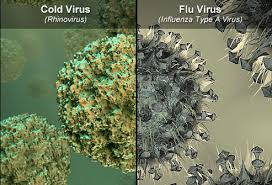According to the Centers for Disease Control and Prevention (CDC), millions of people develop the common cold each year in the United States alone. On average, adults get two or three colds a year, and children have even more.
Many viruses can cause the common cold. Rhinoviruses are the most common cause and are responsible for more than half of all colds and cold-like illnesses.
Rhinovirus infections typically result in mild cold-like symptoms. However, rhinoviruses can also cause more severe illnesses, such as bronchitis and pneumonia, in people with weakened immune systems.
Common colds are the main reason that children miss school and adults miss work. Each year in the United States, there are millions of cases of the common cold.
How it gets in the body:
Most people get colds in the winter and spring, but it is possible to get a cold any time of the year.
Symptoms usually include:
- sore throat
- runny nose
- coughing
- sneezing
- headaches
- body aches
When to See a Doctor:
You should call your doctor if you or your child has one or more of these conditions:
- symptoms that last more than 10 days
- symptoms that are severe or unusual
- if your child is younger than 3 months of age and has a fever or is lethargic
You should also call your doctor right away if you are at high risk for serious flu complications and get flu symptoms such as fever, chills, and muscle or body aches. People at high risk for flu complications include young children (younger than 5 years old), adults 65 years and older, pregnant women, and people with certain medical conditions such as asthma, diabetes, and heart disease.
Your doctor can determine if you or your child has a cold or the flu and can recommend treatment to help with symptoms.
Causes of the Common Cold:
Many different respiratory viruses can cause the common cold, but rhinoviruses are the most common. Rhinoviruses can also trigger asthma attacks and have been linked to sinus and ear infections. Other viruses that can cause colds include respiratory syncytial virus, human parainfluenza viruses, adenovirus, human coronaviruses, and human metapneumovirus.
Treatment:
Most people recover within about 7-10 days. However, people with weakened immune systems, asthma, or respiratory conditions may develop serious illness, such as bronchitis or pneumonia.
There is no cure for a cold. To feel better, you should get lots of rest and drink plenty of fluids. Over-the-counter medicines may help ease symptoms but will not make your cold go away any faster. Always read the label and use medications as directed. Talk to your doctor before giving your child nonprescription cold medicines, since some medicines contain ingredients that are not recommended for children. Learn more about symptom relief of upper respiratory infections, including colds.
Antibiotics will not help you recover from a cold caused by a respiratory virus. They do not work against viruses, and they may make it harder for your body to fight future bacterial infections if you take them unnecessarily.
